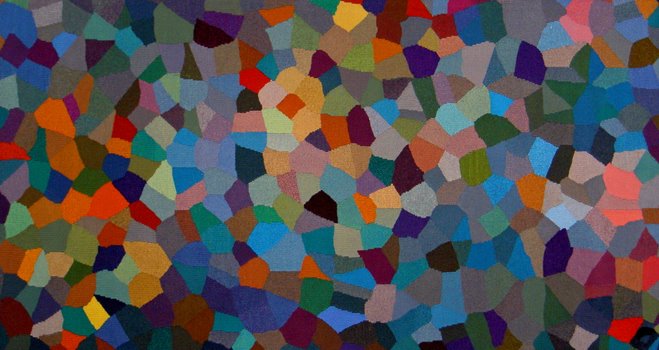Bonnie Klatt sent pictures of the progress of weaving her shape.
The Fate, Destiny and Self Determination/le sort, le destin et l'auto determination project continues to evolve. To date I have received 162 submissions from 22 different countries. You can see the progress of the project on the Facebook page: https://www.facebook.com/pages/Fate-Destiny-and-Self-Determination-An-international-tapestry-project. I recently received news from my sister in France and in it she stated that this project must be all wrapped up by now. Of course, it's far from it. I guess she hasn't seen exactly how tapestry weaving is done and how slow and laborious it is. It will probably be a good 6 months before it is entirely ready for display. The tapestry panel that was recently completed in terms of weaving, is now ready to have us do the 'finishing' processes'. Agota Dolinay did a huge amount of it over the Holiday Season and we are grateful indeed. More work still needs to be done on the finishing, so if you have an hour or two to spare, please come to the Toronto Weaving School (at no charge ) to help us with the finishing. You don't have to know how to weave to do it. You can come Monday and/or Wednesday between 10am-9pm, 255 Royal York Road, 2nd Floor, Toronto. tapestryline@sympatico.ca.I associate fate and destiny to some kind of quest. What that quest is, varies from individual to individual. I love to look up definitions of words because it helps me to apprehend the word in greater dimension and depth. and when I looked up quest these are some of the definitions I found.
- a long and difficult effort to find or do something. (This would definitely apply to tapestry weaving! )
- an investigation
- an act or instance of seeking, pursuit
- a chivalrous enterprise in medieval stories involving an adventurous journey
Bonnie Klatt, Buffulo, New York
Bonnie does mostly liturgical commissions. Her work can be viewed on her Facebook page: https://www.facebook.com/bonnie.klatt.5?fref=ts
In religion, mythology and literature, a quest usually involves a journey that is required to accomplish a (lofty) goal and is often the central focus of the plot, and usually a symbol or metaphor. Quests appear in the folklore of most cultures and usually require a 'hero' to overcome the great obstacles that are strewn on his/her path. This often includes much travel.
Christa Weitbrecht, Germany
Recently I was looking at Jean Lurcat's tapestries "Le Chant du Monde", inspired by the Apocalypse tapestries in Angers and where they now hang at the musee Jean Lurcat in Angers, once a hospital for orphaned children. Therese Jarry (France), who submitted a shape for this project a while back, sent me this book as well as another book on the Apocolypse tapestries that also hang in Angers, France.Lurcat definitely fits the 'hero' archetype as found in literature and myth. He traveled extensively throughout his life. According to numerous definitions a 'hero' describes someone who in the face of danger, adversity, challenges or position of weakness or disadvantage, displays courage and the will to undergo discomforts and/or sacrifices in the effort of obtaining some greater good for others, which is usually cathartic. The 'hero' also holds exemplary moral beliefs and seeks to personify that in his/her behavior. The word 'hero' originates from the Greek and literally translated meant "protector" and "defender". In that light, Jean Lurcat clearly stepped into that role for tapestry.
Christa Weitbrecht, Germany
Joseph Campbell in his book The Hero with a Thousand Faces, describes several uniting themes or stages of the hero in a story which are universal, in spite of the vast differences in cultures and language. The 'Hero's Journey', called a monomyth, consists of three separate stages, including the Departure, Initiation and Return. "Within these stages there are several archetypes that the hero or heroine may personify including the call to adventure (which they may initially refuse), supernatural aid, proceeding down a road of trials, achieving a realization about themselves (or an apotheosis), and attaining the freedom to live through their quest or journey." Wikipedia.
In Jungian psychology, the quest is one of seeking wholeness, defined as the "integration of conscious and unconsious components of the psyche) through individuation. Jung identified instinctual behavioral patterns that he named 'archetypes'.
And to help you on your 'quest' here are a few inspiring links and resources for you to feed the fire of inspiration and enthusiasm.
EXHIBITIONS
North Caroline, USA. Sylvia Hayden and Edith London: Together Again. Durham Arts Council http://www.durhamarts.org/exhibits.html
Angers, France. Artapestry3: Aller-Retour
RESOURCES
Rebecca Mezoff reviews a book on tapestry weaving: http://rebeccamezoff.blogspot.ca/2013/12/the-threads-course-in-tapestry.html
Apocolypse tapestries: http://en.wikipedia.org/wiki/Apocalypse_Tapestry
Musee Jean Lurcat http://musees.angers.fr/les-musees/musee-jean-lurcat-et-de-la-tapisserie-contemporaine/le-lieu/index.html
The Apocalypse Tapestry of Angers, Liliane Delwasse. http://www.goodreads.com/book/show/18323254-the-apocalypse-tapestry-of-angers
Jean Lurcat: le chant du monde angers. You tube video describing the tapestries: http://www.youtube.com/watch?v=I3qsnrjutVQ
Tapestry weaving classes continue at the Toronto Weaving School. For more information contact Line Dufour at tapestryline@sympatico.ca.










No comments:
Post a Comment